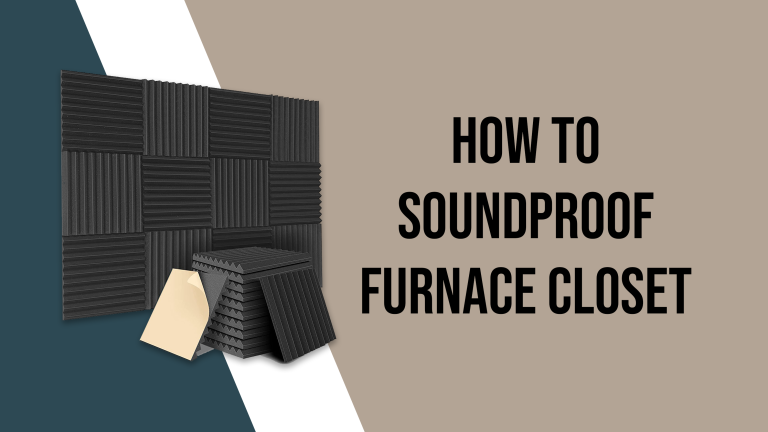How to Soundproof Existing Windows – Enhance Your Comfort
Standard windows are not good at keeping noise out. If your windows are facing a street, you might hear different loud sounds such as car noises, barking dogs, and noisy neighbors. A way to reduce the noise in your place is by getting soundproof windows. However, they can be expensive, and you will probably need to hire professionals to install them.
First of all it’s important to know how noise gets through your windows. Sound can enter through your windows in a few ways: through the window glass itself, through any openings or spaces around the window, or even through the nearby walls.
In this guide, I will explain how to Soundproof Existing Windows better to keep noise out.
Why Soundproof Your Windows?
Most people ask can you soundproof existing windows. First, we understand why making your windows soundproof is a good idea. Soundproofing windows has a few important benefits, such as:
Privacy: Soundproofing also helps keep your conversations and other sounds from being heard by neighbors or people passing by, giving you more privacy.
Noiseless: The main importance of soundproofing is to make sure less noise from outside gets into your home. This can make your home a more peaceful and better place for relaxing and focusing.
Energy Efficiency: Some soundproofing methods can also make your home use energy more efficiently by stopping drafts and heat from escaping.
Better Sleep: If you live in a noisy neighborhood or near a busy street, soundproof windows can help you get a better sleep by blocking out disruptive sounds.
Health Benefits: Making sure you do not hear too much loud noise can make your mind and body feel better. It can lower your stress and keep you from getting sick because of too much noise.
Step-by-step process of how to Soundproof Existing Windows
Step No.1: Find the Problem Areas
To get started, first, figure out which windows in your home are most likely to let in noise. Usually, it’s the windows facing busy streets or those close to noisy sources that need soundproofing the most.
Step 2: Choose Your Soundproofing Method
There are different methods you can use to soundproof your windows, and your choice will depend on your budget and the level of noise you want to block.
Here are some common methods:
Seal Gaps: Weatherstripping is a budget-friendly method where you seal gaps and cracks around your window frames to stop drafts and noise.
Window Inserts: Acoustic window inserts are special panels made to fit over your current windows. They add an extra layer of protection against noise and help insulate your home better.
Window Films: Soundproof window films are sticky films you can put on your window glass. They reduce noise by giving your windows an extra layer of protection.
Acoustic Curtains: These curtains are designed to absorb and block out sound. They are easy to install and can be an effective solution for reducing noise.
Sealant and Caulk: You can use sealant and caulk to close any openings and cracks around your window frames. This is the best way to reduce drafts and noise.
Plexiglass: To make your windows quieter, you can add plexiglass to existing windows to soundproof. You can reduce noise from outside by attaching a layer of plexiglass to your existing windows. Plexiglass is like a strong, see-through shield that helps block out sounds. First, measure your windows, and then get the right-sized plexiglass sheets. Place them over your windows and secure them in place.
Upgrading Windows: You can make existing windows more soundproof. If you are want invest more, consider replacing your existing windows with double or triple-pane windows designed for better sound insulation.
Make a Window Plug: A window plug is a great way to stop noise from coming through your window. It works really well in your bedroom or when you only need a temporary noise solution. But remember, it blocks out light too. You can put it in at night when you sleep and take it out during the day. Make sure your window plug fits perfectly in your window, with no gaps that let noise in. To make it easier to put in and take out, you can add a handle.
Step 3: Collect Materials
After you have decided which soundproofing method to use, collect the materials you need. For most methods, you will require basic tools like a measuring tape, a utility knife, and a caulking gun. Depending on your chosen method, you might also need specific materials like weather stripping, acoustic curtains, window inserts, and window film.
Step 4: Prepare Your Workspace
Before you begin installing, make sure to clear the space around your windows. Take away any furniture, curtains, or anything that might disturb your work. This will make the installation easier and safer.
Step 5: Install the Soundproofing Materials
Now, it’s time to apply your selected soundproofing materials. Here’s a ways of how to install some common soundproofing materials:
- To add weatherstripping to your windows, start by measuring the gaps around your window frames accurately. Once you have the measurements, cut the weatherstripping to fit those dimensions. Then, carefully apply the weatherstripping to the gaps, making sure it creates a tight seal when the window is closed. This simple step can reduce drafts and noise infiltration, making your living space more comfortable.
- When hanging curtains for soundproofing, make sure they fully cover the entire window area and create a tight seal against the wall. This means the curtains should be wide enough to extend beyond the window frame on both sides and long enough to touch the windowsill or floor. For even better noise reduction, choose heavy or thermal curtains and use curtain rods that fit against the wall to minimize gaps.
- To install custom made inserts over your existing windows, make sure the inserts are the right size for your windows and carefully place the inserts over your windows.
- To install soundproof window film, begin by cleaning your window panes thoroughly to ensure a clean surface. Now, attach the sticky film as per the instructions, ensuring it sticks evenly and smoothly on the glass. To get rid of air bubbles and seal it right, use a squeegee to press the film onto the window. This added layer of soundproofing can make your living space quieter and better for relaxation and focus.
- To seal gaps or cracks around your window frames, first, choose caulk. Next, apply it into the gaps, making sure to fill them completely. For a neat look, use a caulking gun to apply the sealant carefully. Afterward, smooth it out with your finger or a tool. This process helps prevent drafts and noise from entering your home, making your living space more comfortable.
Step 6: Test for Effectiveness
After installing the soundproofing materials, it’s important to test their effectiveness. Close all the windows and doors in the room and listen for any noticeable reduction in outside noise. You can also perform a sound test by playing music or making noise outside and then checking if it’s noticeably quieter inside. This way, you can check how well your soundproofing works and make any changes if needed for a quieter and calmer living space.
Step 7: Check and Adjust
If the noise is still bothering you, try changing things or using more than one soundproofing method. You can use both soundproof curtains and window inserts for better results. Layering them like this can make your home quieter and more comfortable.
Step 8: Maintain Your Soundproofing
Remember, regular upkeep is important to keep your soundproofing materials effective over time. Check them for wear, gaps, or damage, and fix or replace as needed. This approach will help maintain the soundproofing performance of your windows and ensure a peaceful and quiet living environment.
Conclusion
Don’t worry about whether can you make existing windows more soundproof. Soundproofing your existing windows can enhance your quality of life by minimizing unwanted noise and increasing your privacy. Whether you choose weatherstripping, acoustic curtains, window inserts, and window films. The important thing is to follow our complete guide of how to Soundproof Existing Windows. With a quieter and more serene living environment, you can fully relish the comfort and peace you deserve.
You can read: 11 Ways to Soundproof a Window
FAQs
How can I soundproof my existing windows cheaply?
You can soundproof your existing windows on a budget-friendly by using methods like sealing gaps with caulk or weatherstripping, adding heavy curtains, or applying soundproof window film. These cost-effective solutions help reduce noise.
How much does it cost to soundproof an existing window?
The cost to soundproof an existing window can vary based on the method you choose. DIY Options like weatherstrips or window film can be cheap. But if you want acoustic window inserts or replacing the whole window, it can be pricier, starting at hundreds of dollars and going up to a few thousand dollars for each window.
What are the best noise-blocking windows?
The effectiveness of noise-blocking windows depends on your specific needs and budget. Common solutions include acoustic curtains, window inserts, and soundproofs window film. Double or triple-pane windows are also highly effective but can be pricier.
What is the best solution for soundproofing existing windows?
The best solution for soundproof your existing windows varies depending on your requirements. You can save money and get good results by using a combination of methods like adding thick curtains, sealing gaps, and using soundproof window film. For higher budgets, acoustic window inserts or window replacement with double or triple-pane windows offer superior noise reduction.








